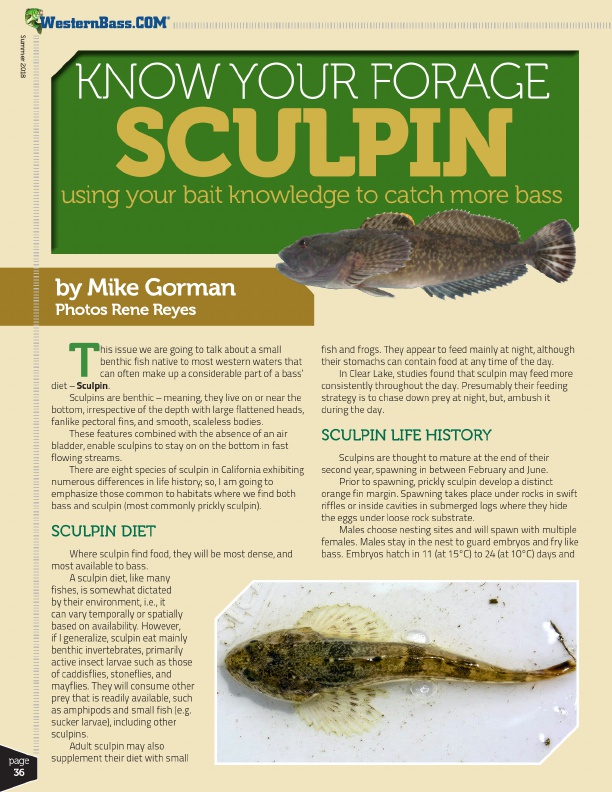
Summer 2018
®
KNOW YOUR FORAGE
SCULPIN
using your bait knowledge to catch more bass
by Mike Gorman
Photos Rene Reyes
page
36
T
his issue we are going to talk about a small
benthic fish native to most western waters that
can often make up a considerable part of a bass’ diet – Sculpin .
Sculpins are benthic – meaning, they live on or near the
bottom, irrespective of the depth with large flattened heads,
fanlike pectoral fins, and smooth, scaleless bodies.
These features combined with the absence of an air
bladder, enable sculpins to stay on on the bottom in fast
flowing streams.
There are eight species of sculpin in California exhibiting
numerous differences in life history; so, I am going to
emphasize those common to habitats where we find both
bass and sculpin (most commonly prickly sculpin).
SCULPIN DIET
Where sculpin find food, they will be most dense, and most available to bass.
A sculpin diet, like many fishes, is somewhat dictated by their environment, i.e., it can vary temporally or spatially based on availability. However, if I generalize, sculpin eat mainly benthic invertebrates, primarily active insect larvae such as those of caddisflies, stoneflies, and mayflies. They will consume other prey that is readily available, such as amphipods and small fish (e.g. sucker larvae), including other sculpins.
Adult sculpin may also supplement their diet with small
fish and frogs. They appear to feed mainly at night, although their stomachs can contain food at any time of the day.
In Clear Lake, studies found that sculpin may feed more consistently throughout the day. Presumably their feeding strategy is to chase down prey at night, but, ambush it during the day.
SCULPIN LIFE HISTORY
Sculpins are thought to mature at the end of their second year, spawning in between February and June.
Prior to spawning, prickly sculpin develop a distinct orange fin margin. Spawning takes place under rocks in swift riffles or inside cavities in submerged logs where they hide the eggs under loose rock substrate.
Males choose nesting sites and will spawn with multiple females. Males stay in the nest to guard embryos and fry like bass. Embryos hatch in 11 (at 15°C) to 24 (at 10°C) days and